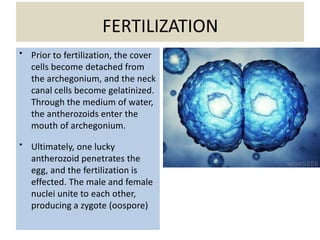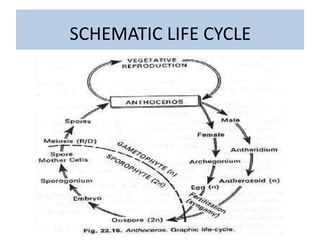2. anthocerospp
- 2. Distribution and Habitat of Anthoceros: •Anthoceros is represented by about 200 species. • All species are terrestrial and cosmopolitan in distribution. •The species grow in very moist and shady places like slopes, rocks or sides of the ditches. •Some species are found growing on decaying wood (Cavers, 1911). Unlike other bryophytes Anthoceros is usually not well adapted to resist dry conditions. •ఆంథోసెరోస్ యొక్క పంపిణీ మరియు నివాస: ఆంథోలోరోస్ సుమారు 200 జాతులచే సూచంచబడుతుంది. అనిి జాతులు పంపిణీలో భూమి మరియు కాస్మ ోపాలిటన్. ఈ జాతులు చాలా తడిగా మరియు చీక్టి పరదేశాలోో వాలు, రాళ్ళు లేదా గుంటలు యొక్క భుజాలు వంటివి పెరుగుతాయి. కొనిి జాతులు క్షయించే చెక్క మీద పెరుగుతాయి (కావెర్స్, 1911). ఇతర bryophytes కాక్ుండా Anthoceros స్ాధారణంగా పొ డి పరిసిితులు అడుు కోవటానికి సవీక్రించారు లేదు
- 4. Habitat • Distributed world wide • Grows in shady and moist areas of tropical and temperate regions • About 200 species, and in Pakistan 3 common species are found in himaliyas 1. 2. 3. Anthoceros himalayensis Anthoceros erectus Anthoceros chambensis
- 5. Vegetative morphology Thallus The plant body is gametophyte and consist of small, dark green, prostrate thallus It is rosette like, and with lobes of whose margins are divided into small lobed segments Dichotomous system is present Surface of thallus is smooth, velvety , and contains ridges and spines Numerous thread like rhizoids are present on ventral surface of thallus
- 6. Thallus
- 7. Internal structure of thallus • There is no internal differentiation • Parenchymatous cells are present • Each contain single lens shaped chloroplast • Deep cells contain 2-8 chloroplasts • Each chloroplast contains single pyrenoid • There are two surfaces, upper and lower epidermis • Lower epidermis contains mucilaginous cavities that opens through a pore called slime pore • In these cavities blue green alga resides.
- 10. Vegetative reproduction 1. Death of older plants: Vegetative reproduction takes place by thedeath of older parts.Younger parts form new thallus. 2. Tuber: Some thallus forms tubers. These tubers are rich in stored fats and proteins. These tubers germinate to on the margin of the lobes. They can survive long periods of drought. Tuber detach and from new plants. 3. Gemmae: Gemma are also produced on short stalks on the upper surface of the thallus. These are also act as vegetative reproductive bodies. 4. Persistent apices : in some species the thallus dies except the apices , there are called persistent apices , they remain buried in soil and develop into new plant body during favorable conditions
- 12. CLASSIFICATION • KINGDOM : Plantae • DIVISION: Anthocerotophyta • CLASS: Anthocerotopsida • ORDER: Anthocerotales • FAMILY: Anthocerotaceae • GENUS: Anthoceros
- 14. VEGETATIVE REPRODUCTION • It takes place by the following methods: • Progressive death and decay of thallus. • By tubers. • By Gemmae. • By persistent growing apices.
- 15. Death and decay of thallus • Not a very common method. More common in Liverworts. • Part of lobes form a new gametophyte.
- 16. BY TUBERS • Tubers have an outer protective corky layer and resist extreme desiccation. They remain alive even after the death of the thallus. In sufficient moisture, they germinate and give rise to new plant.
- 17. By Gemmae • Some species like A. glandulosus , A. formaosae and A. fusiformis bear stalked structures on dorsal surface called called gemmae. On separation from parent thallus they give rise to new plants.
- 18. By persistent growing apices. • Species like A. pearsoni and A. fusiformis employ this method. • Mostly in areas where summer season is very dry. • All parts of thallus except apical regions become dry. These Apices later after period of dormancy for new plant.
- 20. ANTHERIDIA • They occur endogenously on dorsal surface in a closed cavity called antheridial chambers. • They enclose mass of androcytes which mature into antherozoids.
- 23. Antherozoids • The antherozoid is spindle like and biciliate. • The cilia are attached to the anterior end of the body. • The antherozoids swim in the water by the lashing moment of their flagella.
- 24. DEVELOPMENT OF ARCHEGONIUM The development of archegonium begins from a single superficial cell. This cell becomes prominent and acts as archegonial initial. The archegonial initial first divides vertically, producing three jacket initials which surround an axial cell. The axial cell divides transversely, producing a cover initial and a central cell. Thereafter, the central cell divides by a transverse wall, giving rise to a primary canal cell and a primary venter cell.
- 26. Structure of archegonium • A mature archegonium is flask-like in shape, without neck canal cells and with an egg (oosphere) in its venter. • At the top of the neck of the archegonium there are four cover cells, which become separated from the archegonium, as soon as the gelatinization of the venter and neck canal cells is over.
- 27. FERTILIZATION • Prior to fertilization, the cover cells become detached from the archegonium, and the neck canal cells become gelatinized. Through the medium of water, the antherozoids enter the mouth of archegonium. • Ultimately, one lucky antherozoid penetrates the egg, and the fertilization is effected. The male and female nuclei unite to each other, producing a zygote (oospore)
- 28. DEVELOPMENT OF SPOROGONIUM • With the result of the first vertical division, the daughter cells are produced, which are subjected to a transverse division producing four cells of equal or unequal size • These cells again divide vertically, developing eightcelled embryo, four cells in each tier. The upper tier of four cells divides transversely. This way the three tiers of four cells each have been produced. • The lowermost tier produces the foot, the middle tier produces partly the foot and mainly the seta and the upper-most tier produces the capsule.
- 29. SPOROGONIUM TISSUE • In the young sporogonium, the columella consists of four vertical rows of the cells, but later on it is made up of sixteen rows of cells. • The jacket initials divide again and again periclinally producing the 4 to 6 layered wall of the capsule. • Later on, the sporogenous tissue becomes differentiated into two types of cells, i. e., (i) the sporocytes (spore mother cells) and (ii) the sterile cells (pseudoelaters).
- 33. LIFE CYCLE IN NUTSHELL
- 39. • Occurrence • Polytrichum have worldwide distribution. They are very common in cool temperature and tropical regions. Plants live in cool and shady places. • General structure • The main plant body is gametophyte. The adult plant consists of two parts: rhizome and upright leafy shoot. • 1. Rhizome: It is horizontal portion and grows underground. It bears three rows of small brown or colourless leaves. It also bears rhizoids. The cells are rich in protoplasm and oil globules. • 2. Upright leafy shoot: The leafy shoots are much longer. It is the most conspicuous part of the plant. It arises from rhizome. These branches consist of central axis. These branches bear large leaves arranged spirally.
- 41. • 3. Leaves: Leaves have broad bases. Leaves in the upper portion are green. But the lower ones are brown. Each leaf has a broad. colourless sheathing leaf base and narrow distal limb. • The mid-rib forms the major part of the leaf. These leaves possess extra photosynthetic tissue in the form of closely set vertical plates of green cells. These are known as lamellae. Green lamellae act as additional photosynthetic tissue.
- 42. • Leaf: Polytrichum have complex internal structure. The mid-rib region is thick. But the margins are only one cell thick. The lower surface is bounded by epidermis. One or two layers of sclerenchymatous tissues are present above the epidermis. The central tissue of leaf is composed of thin-walled parenchymatous tissues. Above this are again sclerenchymatous cells. The upper surface is formed of a layer of large cells from which arise numerous lamellae. This upper portion is the main photosynthetic region of the leaf. • Stem: The T.S. of stem shows three regions: medulla, cortex and epidermis. The medulla is again differentiated into two zones: central zone and peripheral zone. The cortex consists of thick- walled cells. The innermost layer of cortex around the conducting strands is known as a mantle. Its cells contain starch grain. Epidermis is present over the cortex.
- 44. • Vegetative reproduction • Vegetative reproduction takes place by following methods: • I. Protonema: The spores germinate to form protonema. Several buds grow on the protonema. Each bud by of its apical cell develops into gametophyte. • 2. These are also called vegetative buds. They are formed on the rhizoids. • 3. Fragmentation: The rhizome gives rise to erect lea& shoots at intervals. Death or breaking of shoots separates the erect branches. These branches behave as independent plants.
























































